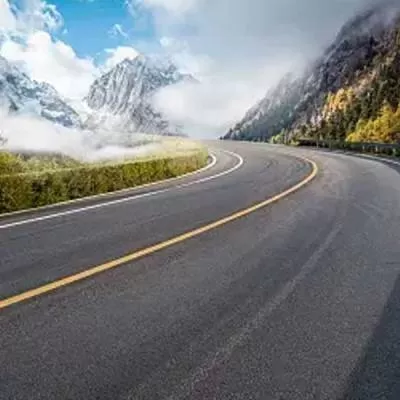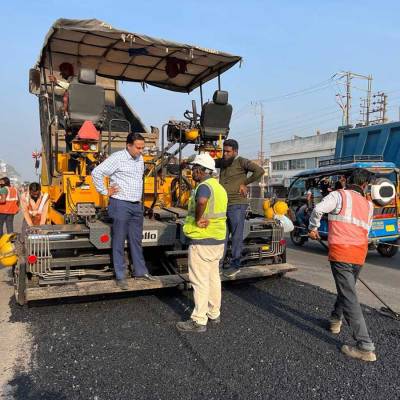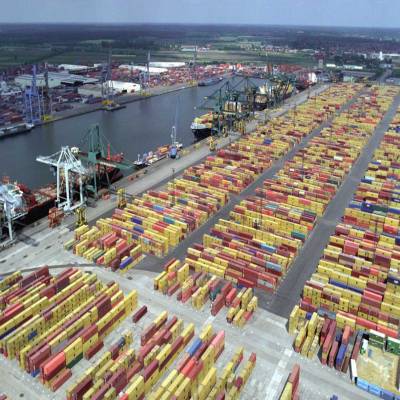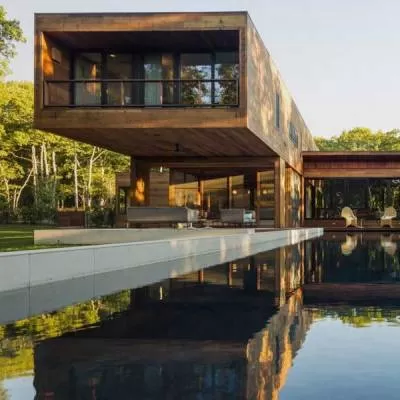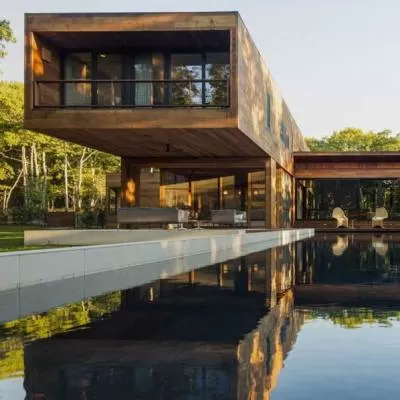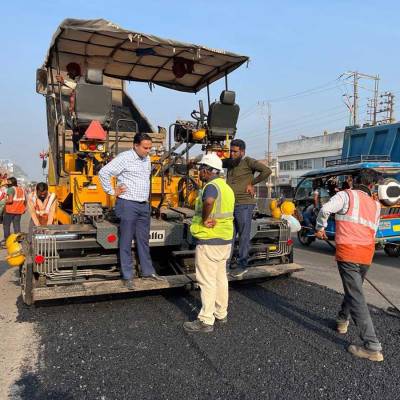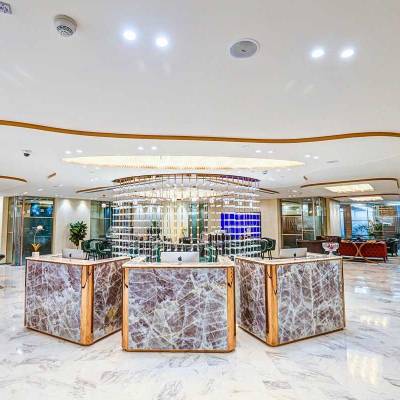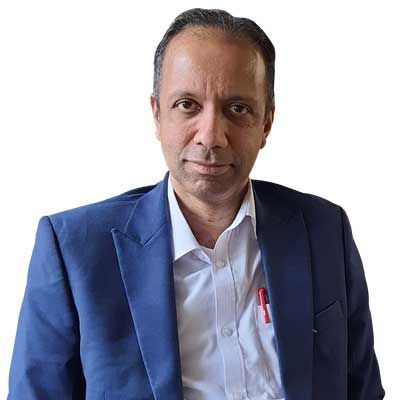- Home
- Real Estate
- High Expectations

High Expectations
Conceiving, financing, designing and constructing a skyscraper is a tall order. Many projects have slow gestation periods, many more have failed to get off the ground or been interrupted and cancelled. According to the Council on Tall Buildings and Urban Habitat´s (CTBUH) in 2014, a total of 50 tall buildings of 150 m or taller have been on hold around the world. On the positive side, the Council´s 2014 Year in Review report stated that 97 buildings of 200 m or higher were completed in 2014 - a new record. Sadly, not even a single project from India made it to the list.
At present, India is better known for the skyscrapers it has not built. The India Tower, planned to rise 700 m above Mumbai, was started in 2010 and stopped in 2011, with only its foundations complete. It currently stands in CTBUH´s Dream Deferred: Unfinished Tall Buildings report as the world´s second-tallest building never to be completed. It also has a higher than average construction duration for tall buildings - about four to six years on average versus two to four globally.
All this begs the question: Is the challenge for India lack of technical expertise or does it lie at the policy level?
International innovations
To set the context, CW first identified some international landmarks from CTBUH´s list of about 97 buildings (list available on www.ConstructionWorld.in/webx) that highlight innovations. Beijing´s second tallest building on completion in 2014, the 267-m Fortune Financial Centre is a Grade-A office tower that is part of the Fortune Plaza project. As design architect firm P&T Group shares, ¨Clad in a full curtain wall with articulated fins all finished in silver coloured aluminium and reflective glass in double-glazing units, a taut and elegant skin is provided to the sculpture tower.¨
Owing to the global downturn, the construction of the Raffles Tower in Jakarta faced slowdown for almost two years with a construction cost, excluding land, of around $100 million. As Artadinata Djangkar, Director, PT Ciputra Property Tbk, says, ¨Building such a luxury residential and hotel building takes time as materials are needed not just in large amounts but high quality. Also, being one of the tallest buildings in Indonesia, it was quite a challenge to bring construction materials and workers up.¨ As a solution, high-speed temporary elevators have been used that can serve up to 250 m above ground.
Meanwhile, completed within three years, Toranomon Hills in Tokyo was built at about Ñ234 billion, including the construction cost of Loop Road No 2. As redevelopment expert Mori Building Co Ltd shares, ¨The third area of Loop Road No 2 is the first example of a three-dimensional road system with the simultaneous construction of a tunnel below ground and a building above ground. The focus was earthquake precaution and to achieve the desired stability, it was necessary to merge the building and tunnel without ´connecting´ the two.¨ The solution: The tunnel´s tube runs through an underground hole connected to the building, bringing both elements into close contact.
Other exciting technologies, according to Daniel Safarik, MArch, Editor, CTBUH, include a lighter carbon-fibre rope that doubles the run a single elevator car can make in a shaft and improving BIM software and electronic monitoring techniques for construction and in-service performance. Sky gardens and other strategies for livening elevator lobbies and improving the human experience are coming into play, as are double-skin facades that ´breathe´ and make buildings more energy-efficient. Safarik also mentions magnetic levitation elevators - not implemented anywhere yet - that can move several cars at once in a shaft, as well as go sideways and composite mega columns.
Where does India stand?
So is India still far behind in the innovation league?
¨The market is evolving and there are good examples of early adopters achieving significant success,¨ says Jeremy Lester, industry expert and most recently CEO of Grocon´s international business. ¨There are a number of excellent tall buildings that are well progressed, but not yet completed. These projects are being built safely, efficiently and with a high degree of precision and quality.¨ In fact, 54 tall buildings in the country are expected to be completed between 2015 and 2017 (see list on page 72).
Timelines are also improving. With the use of conventional construction technology, it takes an average of 15 days to complete a floor cycle in India. Aluminium Formwork is typically a 10 days cycle. Here, Omkar Realtors is creating a new record. Referring to the self-climbing jump form system used in Omkar 1973 Worli, John Guest, Head EPC, Omkar Realtors & Developers, says, ¨This has reduced slab cycle time and construction cost. Savings of three to four days are expected per cycle with reduction in labour for this element of the project by 35 per cent. And a six-day cycle has already been achieved.¨ Also, he adds that this project has used automatic climbing systems for the columns, thus achieving four-day cycles. In Turkey, the floor cycle can be achieved in about two days with tunnel technology. ¨Using the same technology we can complete floor cycles in about three days in India,¨ adds Guest. Meanwhile, Mayur Shah, Managing Director, Marathon Group, tells us, ¨In 2004, we imported aluminium shuttering technology from a Malaysian company to achieve the floor-to-floor cycle in six to eight days. Also, for a 62-storey tower that we are jointly developing with Adani, we recently adapted a Korean jump-form technique that reduces cycle time from 21 days to seven, offering better safety standards. We have also adopted aluminium shuttering, Mivan technology and PERI formwork for our commercial building Marathon Futurex.¨ He adds that high-performance concrete needs to be created accordingly.
The controversial Palais Royale project, which has come to a halt, still remains a case in point for the technology used. Kamal N Hadker, Managing Director, Sterling Engineering Consultancy Services, says, ¨Pre-engineered shuttering has been applied brilliantly and the concrete mixes were so high that they could match international standards.¨ Precast building components are certainly advantageous in tall building construction - if not precast concrete, one can pump up concrete. ¨In Palais Royale, contractors could pump up to 300 m in any case with powerful pumps,¨ he adds, informing us that even steel cages were prefabricated and brought to site. Hadker also mentions slip-form technology, which achieves faster construction as the core goes up first before completing the building. ¨Installation of the lift takes six months and in a tall building after reaching the lift machine room level. By the time you reach this level, it could be two years,¨ he explains. ¨But with the use of slip-form, you can go up faster.¨
Challenging norms
While it is evident that India has its hands on the technology, execution presents a challenge.
¨There are all kinds of permissions to be obtained from municipality, fire department, environment authorities, CRZ approval, etc,¨ says Hadker. ¨At times, one has to go to Delhi and the Airport Authority of India to get approval of the building plans. Amid this, land prices fluctuate and there are frequent changes in bylaws. Structural design and drawings are once again revised to suit the revised architectural plans.¨ Shah agrees, citing the need for multiple NOCs in Mumbai. ¨The high-rise committee and environmental clearance are the two major hurdles other than the fire-fighting NOCs.¨ He says that while environmental clearance sometimes takes 24 months, the high-rise committee takes 12-18 months for approval.
In Safarik´s view, ¨Information transparency is not the best.¨ To this, Naushir De Vitre, Director, Talati & Panthaky Associated Pvt Ltd, says, ¨Various permissions can be linked and sequenced online. In this way, permissions can be more rationalised, faster and transparent, making the entire process more efficient.¨
High committee
That said, the high-rise committee is vital to approval in Mumbai, with every building constructed to 70 m and above having to apply to it. Sharookh Mehta, Director, Talati & Panthaky Associated Pvt Ltd, adds, ¨You need two fire staircases widened to 2.1 m each and refuge floors have to be adequately provided for every building above 70 m.¨ He cites the example of 9/11 in the US, where the firemen could not reach out to the people as the width of the fire staircase was narrow.
For his part, Hadker views its formation positively. ¨Now, calculations cannot be submitted in a casual manner; there is fear of being exposed by the experts sitting there.¨ He urges the formation of such committees across all big cities. However, Shah says, ¨There is a representative from the environment, structural expert, chief fire officer and consultant. Yet, we seek approvals for environment and fire safety; this results in duplication and repetition.¨
Building India
Permissions aside, in cities like Mumbai, Delhi, Bengaluru, Chennai, Hyderabad and Kolkata, the only option in future is to go vertical. As Hadker highlights, ¨Today, construction cost is anywhere between Rs 2,000 and Rs 3,000 sq ft, whereas land cost is Rs 30,000-50,000.¨ Hence, whoever owns the land wants to build as much as possible and build high. To be viable, Shah says, the selling price will be ¨Rs 15,000 per sq ft and above.¨
Typically, tall buildings of 200 m take at least 36-48 months to complete. Thus, following the stability of real estate after the global meltdown, a slew of towers under construction in India should finally make their appearance in 2015-16. If we can deliver on time while maintaining the necessary focus on quality and durability, India could set its own exceptional record in building tall.
- CW
- Tall Building
- CTBUH
- India Tower
- P&T Group
- Aluminium
- Fortune Plaza Project
- Raffles Tower
- Jakarta
- Artadinata Djangkar
- PT Ciputra Property Tbk
- Toranomon Hills
- Daniel Safarik
- MArch
- BIM
- Elevators
- Grocon
- John Guest
- Omkar Realtors & Developers
- Mayur Shah
- Marathon Group
- Adani
- Palais Royale
- Kamal N Hadker
- Sterling Engineering Consultancy Services
- CRZ
- NOCs
- Naushir De Vitre
- Sh
With the number of skyscrapers in India on the rise, CW examines where India ranks in the tall buildings race. Conceiving, financing, designing and constructing a skyscraper is a tall order. Many projects have slow gestation periods, many more have failed to get off the ground or been interrupted and cancelled. According to the Council on Tall Buildings and Urban Habitat´s (CTBUH) in 2014, a total of 50 tall buildings of 150 m or taller have been on hold around the world. On the positive side, the Council´s 2014 Year in Review report stated that 97 buildings of 200 m or higher were completed in 2014 - a new record. Sadly, not even a single project from India made it to the list. At present, India is better known for the skyscrapers it has not built. The India Tower, planned to rise 700 m above Mumbai, was started in 2010 and stopped in 2011, with only its foundations complete. It currently stands in CTBUH´s Dream Deferred: Unfinished Tall Buildings report as the world´s second-tallest building never to be completed. It also has a higher than average construction duration for tall buildings - about four to six years on average versus two to four globally. All this begs the question: Is the challenge for India lack of technical expertise or does it lie at the policy level? International innovations To set the context, CW first identified some international landmarks from CTBUH´s list of about 97 buildings (list available on www.ConstructionWorld.in/webx) that highlight innovations. Beijing´s second tallest building on completion in 2014, the 267-m Fortune Financial Centre is a Grade-A office tower that is part of the Fortune Plaza project. As design architect firm P&T Group shares, ¨Clad in a full curtain wall with articulated fins all finished in silver coloured aluminium and reflective glass in double-glazing units, a taut and elegant skin is provided to the sculpture tower.¨ Owing to the global downturn, the construction of the Raffles Tower in Jakarta faced slowdown for almost two years with a construction cost, excluding land, of around $100 million. As Artadinata Djangkar, Director, PT Ciputra Property Tbk, says, ¨Building such a luxury residential and hotel building takes time as materials are needed not just in large amounts but high quality. Also, being one of the tallest buildings in Indonesia, it was quite a challenge to bring construction materials and workers up.¨ As a solution, high-speed temporary elevators have been used that can serve up to 250 m above ground. Meanwhile, completed within three years, Toranomon Hills in Tokyo was built at about Ñ234 billion, including the construction cost of Loop Road No 2. As redevelopment expert Mori Building Co Ltd shares, ¨The third area of Loop Road No 2 is the first example of a three-dimensional road system with the simultaneous construction of a tunnel below ground and a building above ground. The focus was earthquake precaution and to achieve the desired stability, it was necessary to merge the building and tunnel without ´connecting´ the two.¨ The solution: The tunnel´s tube runs through an underground hole connected to the building, bringing both elements into close contact. Other exciting technologies, according to Daniel Safarik, MArch, Editor, CTBUH, include a lighter carbon-fibre rope that doubles the run a single elevator car can make in a shaft and improving BIM software and electronic monitoring techniques for construction and in-service performance. Sky gardens and other strategies for livening elevator lobbies and improving the human experience are coming into play, as are double-skin facades that ´breathe´ and make buildings more energy-efficient. Safarik also mentions magnetic levitation elevators - not implemented anywhere yet - that can move several cars at once in a shaft, as well as go sideways and composite mega columns. Where does India stand? So is India still far behind in the innovation league? ¨The market is evolving and there are good examples of early adopters achieving significant success,¨ says Jeremy Lester, industry expert and most recently CEO of Grocon´s international business. ¨There are a number of excellent tall buildings that are well progressed, but not yet completed. These projects are being built safely, efficiently and with a high degree of precision and quality.¨ In fact, 54 tall buildings in the country are expected to be completed between 2015 and 2017 (see list on page 72). Timelines are also improving. With the use of conventional construction technology, it takes an average of 15 days to complete a floor cycle in India. Aluminium Formwork is typically a 10 days cycle. Here, Omkar Realtors is creating a new record. Referring to the self-climbing jump form system used in Omkar 1973 Worli, John Guest, Head EPC, Omkar Realtors & Developers, says, ¨This has reduced slab cycle time and construction cost. Savings of three to four days are expected per cycle with reduction in labour for this element of the project by 35 per cent. And a six-day cycle has already been achieved.¨ Also, he adds that this project has used automatic climbing systems for the columns, thus achieving four-day cycles. In Turkey, the floor cycle can be achieved in about two days with tunnel technology. ¨Using the same technology we can complete floor cycles in about three days in India,¨ adds Guest. Meanwhile, Mayur Shah, Managing Director, Marathon Group, tells us, ¨In 2004, we imported aluminium shuttering technology from a Malaysian company to achieve the floor-to-floor cycle in six to eight days. Also, for a 62-storey tower that we are jointly developing with Adani, we recently adapted a Korean jump-form technique that reduces cycle time from 21 days to seven, offering better safety standards. We have also adopted aluminium shuttering, Mivan technology and PERI formwork for our commercial building Marathon Futurex.¨ He adds that high-performance concrete needs to be created accordingly. The controversial Palais Royale project, which has come to a halt, still remains a case in point for the technology used. Kamal N Hadker, Managing Director, Sterling Engineering Consultancy Services, says, ¨Pre-engineered shuttering has been applied brilliantly and the concrete mixes were so high that they could match international standards.¨ Precast building components are certainly advantageous in tall building construction - if not precast concrete, one can pump up concrete. ¨In Palais Royale, contractors could pump up to 300 m in any case with powerful pumps,¨ he adds, informing us that even steel cages were prefabricated and brought to site. Hadker also mentions slip-form technology, which achieves faster construction as the core goes up first before completing the building. ¨Installation of the lift takes six months and in a tall building after reaching the lift machine room level. By the time you reach this level, it could be two years,¨ he explains. ¨But with the use of slip-form, you can go up faster.¨ Challenging norms While it is evident that India has its hands on the technology, execution presents a challenge. ¨There are all kinds of permissions to be obtained from municipality, fire department, environment authorities, CRZ approval, etc,¨ says Hadker. ¨At times, one has to go to Delhi and the Airport Authority of India to get approval of the building plans. Amid this, land prices fluctuate and there are frequent changes in bylaws. Structural design and drawings are once again revised to suit the revised architectural plans.¨ Shah agrees, citing the need for multiple NOCs in Mumbai. ¨The high-rise committee and environmental clearance are the two major hurdles other than the fire-fighting NOCs.¨ He says that while environmental clearance sometimes takes 24 months, the high-rise committee takes 12-18 months for approval. In Safarik´s view, ¨Information transparency is not the best.¨ To this, Naushir De Vitre, Director, Talati & Panthaky Associated Pvt Ltd, says, ¨Various permissions can be linked and sequenced online. In this way, permissions can be more rationalised, faster and transparent, making the entire process more efficient.¨ High committee That said, the high-rise committee is vital to approval in Mumbai, with every building constructed to 70 m and above having to apply to it. Sharookh Mehta, Director, Talati & Panthaky Associated Pvt Ltd, adds, ¨You need two fire staircases widened to 2.1 m each and refuge floors have to be adequately provided for every building above 70 m.¨ He cites the example of 9/11 in the US, where the firemen could not reach out to the people as the width of the fire staircase was narrow. For his part, Hadker views its formation positively. ¨Now, calculations cannot be submitted in a casual manner; there is fear of being exposed by the experts sitting there.¨ He urges the formation of such committees across all big cities. However, Shah says, ¨There is a representative from the environment, structural expert, chief fire officer and consultant. Yet, we seek approvals for environment and fire safety; this results in duplication and repetition.¨ Building India Permissions aside, in cities like Mumbai, Delhi, Bengaluru, Chennai, Hyderabad and Kolkata, the only option in future is to go vertical. As Hadker highlights, ¨Today, construction cost is anywhere between Rs 2,000 and Rs 3,000 sq ft, whereas land cost is Rs 30,000-50,000.¨ Hence, whoever owns the land wants to build as much as possible and build high. To be viable, Shah says, the selling price will be ¨Rs 15,000 per sq ft and above.¨ Typically, tall buildings of 200 m take at least 36-48 months to complete. Thus, following the stability of real estate after the global meltdown, a slew of towers under construction in India should finally make their appearance in 2015-16. If we can deliver on time while maintaining the necessary focus on quality and durability, India could set its own exceptional record in building tall.


